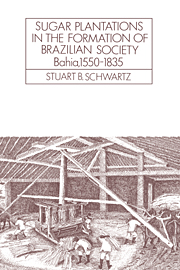Book contents
- Frontmatter
- Contents
- List of figures, maps, and tables
- Preface
- Abbreviations and special terms
- Weights and measures
- Dedication
- Part I Formations, 1500–1600
- Part II The Bahian engenhos and their world
- 4 The Recôncavo
- 5 Safra: the ways of sugar making
- 6 Workers in the cane, workers at the mill
- 7 The Bahian sugar trade to 1750
- 8 A noble business: profits and costs
- Part III Sugar society
- Part IV Reorientation and persistence, 1750–1835
- Appendixes
- Notes
- Glossary
- Sources and selected bibliography
- Sources of figures
- Index
- CAMBRIDGE LATIN AMERICAN STUDIES IN PRINT
7 - The Bahian sugar trade to 1750
Published online by Cambridge University Press: 05 May 2010
- Frontmatter
- Contents
- List of figures, maps, and tables
- Preface
- Abbreviations and special terms
- Weights and measures
- Dedication
- Part I Formations, 1500–1600
- Part II The Bahian engenhos and their world
- 4 The Recôncavo
- 5 Safra: the ways of sugar making
- 6 Workers in the cane, workers at the mill
- 7 The Bahian sugar trade to 1750
- 8 A noble business: profits and costs
- Part III Sugar society
- Part IV Reorientation and persistence, 1750–1835
- Appendixes
- Notes
- Glossary
- Sources and selected bibliography
- Sources of figures
- Index
- CAMBRIDGE LATIN AMERICAN STUDIES IN PRINT
Summary
Heretofore we had all our sugars from Portugal and it is computed that they cost us yearly about £400,000. Now that great leak is stopped; and we hardly buy any Portugal or Brazil sugars.
Groans of the Plantations (London, 1689)It is notorious, calamitous, and deplorable the state in which the sugar planters and cane farmers of the country find themselves, they who are the nerves of the civil and political body. … Everyone feels it, everyone complains, everyone laments that they are lost; but always ill from the same malady, they will not take the medicine or permit reform.
Wenceslāo Pereira da Silva (1732)Sugar became in the sixteenth century the predominant Brazilian export, and until the middle of the nineteenth century it never lost its leading position. Even during the gold rush of the eighteenth century, when Brazilian gold poured into the coffers of Europe and, as Adam Smith noted, helped fuel the industrial revolution, the value of Brazilian sugar exports always exceeded those of any other commodity. But the impression often given in the historiography of the Brazilian economy is that sugar experienced its heyday in the early seventeenth century and then fell into a long period of stagnation or decline, becoming in tjie process virtually moribund. Although it is true that foreign competition severely reduced the Brazilian share of the world sugar market after the mid–seventeenth century, the subsequent history of the sugar sector was not simply one of decline.
- Type
- Chapter
- Information
- Sugar Plantations in the Formation of Brazilian SocietyBahia, 1550–1835, pp. 160 - 201Publisher: Cambridge University PressPrint publication year: 1986



